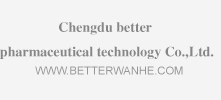 |
Products |
 |
 |
Prodcus Search |
 |
 |
Contact Us |
 |
Chengdu Better Pharmaceutical Technology Co.,Ltd.
Add.:Block B Building 1,No. 1480 of the northern section of Tianfu Avenue,
High-tech Zone,Chengdu City,Sichuan Province,China.
Tel.: +86 28 82252524
Mob.: +86 018908188254
Technical Support: +86 13730622889
|
|
 |
News |
 |
|
Rolapitant Reduced Chemotherapy-Induced Nausea and Vomiting in Patients Receiving Highly Emetogenic Cisplatin-Based ChemotherapyIn two phase III trials reported in The Lancet Oncology, Rapoport et al found that the addition of rolapitant to serotonin (5-HT3) receptor antagonist and dexamethasone treatment significantly improved complete response rates in prevention of chemotherapy-induced nausea and vomiting in patients receiving highly emetogenic cisplatin-based chemotherapy.
Study Details
In the two double-blind phase III trials (HEC-1 and HEC-2), patients from 155 sites (76 in HEC-1 and 79 in HEC-2) in 26 countries (17 in HEC-1 and 14 in HEC-2) were randomly assigned between February 2012 and March 2014 to receive oral rolapitant 180 mg or placebo at 1 to 2 hours before administration of highly emetogenic chemotherapy. All patients received intravenous granisetron 10 μg/kg and oral dexamethasone 20 mg on day 1 and oral dexamethasone 8 mg twice daily on days 2 to 4 for up to six cycles, with a minimum of 14 days.
A total of 526 patients in HEC-1 (264 rolapitant and 262 control patients) and 544 in HEC-2 (271 rolapitant and 273 control patients) received at least one dose of study drug and were included in the modified intention-to-treat population. The primary endpoint was the proportion of patients achieving a complete response, defined as no emesis or use of rescue medication, in the delayed phase (> 24–120 hours after initiation of chemotherapy) in cycle 1.
HEC-1 included greater proportions of women, patients from North America, and cases of ovarian cancer. HEC-2 included greater proportions of patients with lung or stomach cancer.
Delayed Phase Outcomes
Significantly greater proportions of patients in the rolapitant groups achieved complete response during the delayed phase in both HEC-1 (73% vs 58%, odds ratio [OR] = 1.9, P = .0006) and HEC-2 (70% vs 62%, OR = 1.4, P = .0426) and in the pooled population (71% vs 60%, OR = 1.6, P = .0001).
Acute and Total Phase Outcomes
For the acute phase, rolapitant was associated with a significantly higher complete response rate in HEC-1 (84% vs 74%, P = .0051) but not in HEC-2 (83% vs 79%, P = .2331) and with significant benefit in the pooled population (84% vs 77%, P = .0045). For the total phase (0–120 hours), rolapitant was associated with a significantly higher complete response rate in HEC-1 (70% vs 56%, P = .0013) but not in HEC-2 (68% vs 60%, P = .0840) and with significant benefit in the pooled population (69% vs 59%, P = .0005).
Adverse Events
The incidence of adverse events was similar in rolapitant and control groups. The most commonly reported treatment-related adverse events during cycle 1 were headache (< 1% vs < 1%), hiccups (< 1% vs < 1%), constipation (< 1% vs < 1%), and dyspepsia (< 1% vs < 1%). The most common grade ≥ 3 adverse events in cycle 1 were neutropenia (3% vs 5% in HEC-1, 6% vs 5% in HEC-2), anemia (< 1% vs < 1% in HEC-1, 3% vs < 1% in HEC-2), and leukopenia (2% vs < 1% in HEC-1, < 1% vs < 1% in HEC-2). No serious adverse events were considered treatment-related.
The investigators concluded: “Rolapitant in combination with a 5-HT3 receptor antagonist and dexamethasone is well tolerated and shows superiority over active control for the prevention of chemotherapy-induced nausea and vomiting during the at-risk period (120 h) after administration of highly emetogenic cisplatin-based chemotherapy.” |
|
|
